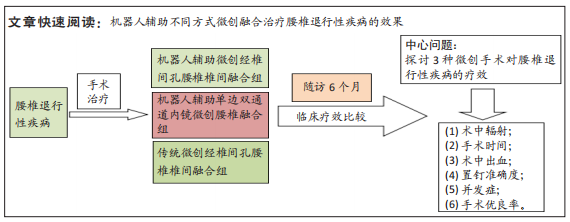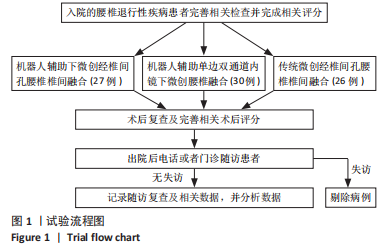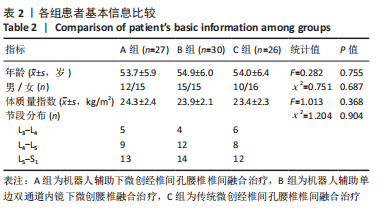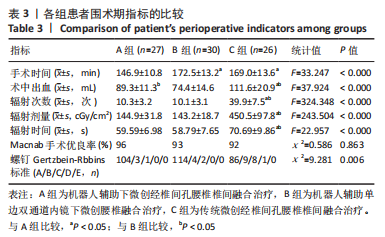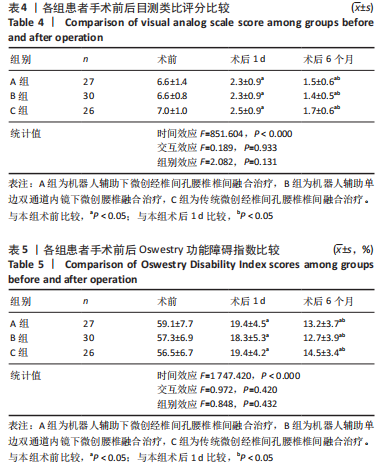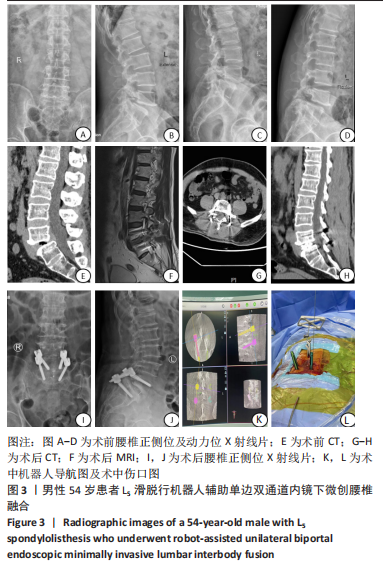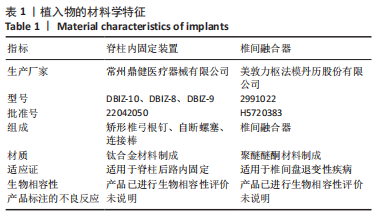[1] DU J, YAND J, YAN L, et al. Intraoperative anti-inflammatory drugs combined with no drainage after MIS-TLIF in the treatment of recurrent lumbar disc herniation: an RCT. J Orthop Surg Res. 2021;16(1):20.
[2] FOLEY KT, HOLLY LT, SCHWENDER JD. Minimally invasive lumbar fusion. Spine. 2003;28(15 Suppl):S26-S35.
[3] HEO DH, SON SK, EUM JH, et al. Fully endoscopic lumbar interbody fusion using a percutaneous unilateral biportal endoscopic technique: technical note and preliminary clinical results. Neurosurg Focus. 2017; 43(2):E8.
[4] KIM CH, EASELEY K, LEE JS, et al. Comparison of Minimally Invasive Versus Open Transforaminal Interbody Lumbar Fusion. Global Spine J. 2020;10(2 Suppl):143s-150s.
[5] HERREN C, REIJNEN M, PISHNAMAZ M, et al. Incidence and Risk Factors for Facet Joint Violation in Open Versus Minimally Invasive Procedures During Pedicle Screw Placement in Patients with Trauma. World Neurosurg. 2018;112:e711-e718.
[6] 李亭, 刘希麟, 王飞, 等. 机器人辅助微创经椎间孔腰椎椎间融合治疗腰椎退行性疾病:置钉精度及其安全性[J]. 中国组织工程研究, 2022,26(36):5812-5818.
[7] LI T, YAN J, HU J, et al. Efficacy and safety of electroacupuncture for carpal tunnel syndrome (CTS): A systematic review and meta-analysis of randomized controlled trials. Front Surg. 2022;9:952361.
[8] LI T, YAN J, REN Q, et al. Efficacy and Safety of Lumbar Dynamic Stabilization Device Coflex for Lumbar Spinal Stenosis: A Systematic Review and Meta-analysis. World Neurosurg. 2023;170:7-20.
[9] KOC M, BAYAR B, BAYAR K. A Comparison of Back Pain Functional Scale With Roland Morris Disability Questionnaire, Oswestry Disability Index, and Short Form 36-Health Survey. Spine. 2018;43(12):877-882.
[10] SWANSON BT, CREIGHTON D. The degenerative lumbar disc: not a disease, but still an important consideration for OMPT practice: a review of the history and science of discogenic instability. J Man Manip Ther. 2020;28(4):191-200.
[11] LI Y, DAI Y, WANG B, et al. Full-Endoscopic Posterior Lumbar Interbody Fusion Via an Interlaminar Approach Versus Minimally Invasive Transforaminal Lumbar Interbody Fusion: A Preliminary Retrospective Study. World Neurosurg. 2020;144:e475-e482.
[12] DERMAN PB, ALBERT TJ. Interbody Fusion Techniques in the Surgical Management of Degenerative Lumbar Spondylolisthesis. Curr Rev Musculoskelet Med. 2017;10(4):530-538.
[13] MOBBS RJ, PHAN K, MALHAM G, et al. Lumbar interbody fusion: techniques, indications and comparison of interbody fusion options including PLIF, TLIF, MI-TLIF, OLIF/ATP, LLIF and ALIF. J Spine Surg. 2015; 1(1):2-18.
[14] HAWS BE, KHECHEN B, NARAIN AS, et al. Iliac Crest Bone Graft for Minimally Invasive Transforaminal Lumbar Interbody Fusion: A Prospective Analysis of Inpatient Pain, Narcotics Consumption, and Costs. Spine. 2018;43(18):1307-1312.
[15] EUN SS, EUM JH, LEE SH, et al. Biportal Endoscopic Lumbar Decompression for Lumbar Disk Herniation and Spinal Canal Stenosis: A Technical Note. J Neurol Surg A Cent Eur Neurosurg. 2017;78(4):390-396.
[16] KIM HJ, JUNG WI, CHANG BS, et al. A prospective, randomized, controlled trial of robot-assisted vs freehand pedicle screw fixation in spine surgery. Int J Med Robot. 2017;13(3). doi: 10.1002/rcs.1779.
[17] 李亭, 张伟, 胡豇, 等. 机器人辅助微创手术与非手术治疗在胸腰椎损伤分类与严重度评分4分胸腰椎骨折患者中的临床疗效研究[J]. 华西医学,2022,37(10):1460-1464.
[18] 陈盼, 郑丹扬, 丁伟国, 等. 单边双通道内镜下椎间盘切除术治疗高度游离型腰椎间盘突出症[J]. 中国修复重建外科杂志,2022, 36(7):860-865.
[19] PRANATA R, LIM MA, VANIA R, et al. Biportal Endoscopic Spinal Surgery versus Microscopic Decompression for Lumbar Spinal Stenosis: A Systematic Review and Meta-Analysis. World Neurosurg. 2020;138: e450-e458.
[20] YANG JS, HE B, TIAN F, et al. Accuracy of Robot-Assisted Percutaneous Pedicle Screw Placement for Treatment of Lumbar Spondylolisthesis: A Comparative Cohort Study. Med Sci Monit. 2019;25:2479-2487.
[21] MOLLIQAJ G, SCHATLO B, ALAID A, et al. Accuracy of robot-guided versus freehand fluoroscopy-assisted pedicle screw insertion in thoracolumbar spinal surgery. Neurosurg Focus. 2017;42(5):E14.
[22] MACKE JJ, WOO R, VARICH L. Accuracy of robot-assisted pedicle screw placement for adolescent idiopathic scoliosis in the pediatric population. J Robot Surg. 2016;10(2):145-150.
[23] PREDOME-PANTOJA A, ISHIDA W, ZYGOURAKIS C, et al. Accuracy of Current Techniques for Placement of Pedicle Screws in the Spine: A Comprehensive Systematic Review and Meta-Analysis of 51,161 Screws. World Neurosurg. 2019;126:664-678.e3.
[24] FU W, TONG J, LIU G, et al. Robot-assisted technique vs conventional freehand technique in spine surgery: A meta-analysis. Int J Clin Pract. 2021;75(5):e13964.
[25] YU L, CHEN X, MARGALIT A, et al. Robot-assisted vs freehand pedicle screw fixation in spine surgery - a systematic review and a meta-analysis of comparative studies. Int J Med Robot. 2018;14(3):e1892.
[26] LIU H, CHEN W, WANG Z, et al. Comparison of the accuracy between robot-assisted and conventional freehand pedicle screw placement: a systematic review and meta-analysis. Int J Comput Assist Radiol Surg. 2016;11(12):2273-2281.
[27] LI HM, ZHANG RJ, SHEN CL. Accuracy of Pedicle Screw Placement and Clinical Outcomes of Robot-assisted Technique Versus Conventional Freehand Technique in Spine Surgery From Nine Randomized Controlled Trials: A Meta-analysis. Spine. 2020;45(2):E111-E119.
[28] LI C, LI W, GAO S, et al. Comparison of accuracy and safety between robot-assisted and conventional fluoroscope assisted placement of pedicle screws in thoracolumbar spine: A meta-analysis. Medicine. 2021;100(38):e27282.
[29] HYUN SJ, KIM KJ, JAHNG TA, et al. Minimally Invasive Robotic Versus Open Fluoroscopic-guided Spinal Instrumented Fusions: A Randomized Controlled Trial. Spine. 2017;42(6):353-358.
[30] AGARWAL N, WHITE MD, ZHANG X, et al. Impact of endplate-implant area mismatch on rates and grades of subsidence following stand-alone lateral lumbar interbody fusion: an analysis of 623 levels. J Neurosurg Spine. 2020:1-5. doi: 10.3171/2020.1.SPINE19776.
[31] YAO YC, CHOU PH, LIN HH, et al. Risk Factors of Cage Subsidence in Patients Received Minimally Invasive Transforaminal Lumbar Interbody Fusion. Spine. 2020;45(19):E1279-E1285.
[32] SINGHATANADGIGE W, SUKTHUAYAT A, TANAVIRIYACHAI T, et al. Risk factors for polyetheretherketone cage subsidence following minimally invasive transforaminal lumbar interbody fusion. Acta Neurochir. 2021;163(9):2557-2565.
[33] MACKI M, ANAND SK, SURAPANENI A, et al. Subsidence Rates After Lateral Lumbar Interbody Fusion: A Systematic Review. World Neurosurg. 2019;122:599-606.
[34] CHOI G, KANG HY, MODI HN, et al. Risk of developing seizure after percutaneous endoscopic lumbar discectomy. J Spinal Disord Tech. 2011;24(2):83-92.
[35] YANG DS, LI NY, KLEINHENZ DT, et al. Risk of Postoperative Complications and Revision Surgery Following Robot-assisted Posterior Lumbar Spinal Fusion. Spine. 2020;45(24):E1692-E1698.
[36] RINGEL F, STUER C, REINKE A, et al. Accuracy of robot-assisted placement of lumbar and sacral pedicle screws: a prospective randomized comparison to conventional freehand screw implantation. Spine. 2012;37(8):E496-E501.
[37] ZHOU LP, ZHANG RJ, LI HM, et al. Comparison of Cranial Facet Joint Violation Rate and Four Other Clinical Indexes Between Robot-assisted and Freehand Pedicle Screw Placement in Spine Surgery: A Meta-analysis. Spine. 2020;45(22):E1532-E1540.
[38] KANG T, PARK SY, LEE SH,et al. Assessing changes in cervical epidural pressure during biportal endoscopic lumbar discectomy. J Neurosurg Spine. 2020:1-7.
[39] JUBBAL KT, CHANG D, IZADDOOST SA, et al. Resident Involvement in Microsurgery: An American College of Surgeons National Surgical Quality Improvement Program Analysis. J Surg Educ. 2017;74(6):1124-1132.
[40] LEE KH, YEO W, SOEHARNO H, et al. Learning curve of a complex surgical technique: minimally invasive transforaminal lumbar interbody fusion (MIS TLIF). J Spinal Disord Tech. 2014;27(7):E234-E240.
[41] KOVARI VZ, KUTI A, KONYA K, et al. Comparison of Single-Level Open and Minimally Invasive Transforaminal Lumbar Interbody Fusions Presenting a Learning Curve. Biomed Res Int. 2020;2020:3798537. |
